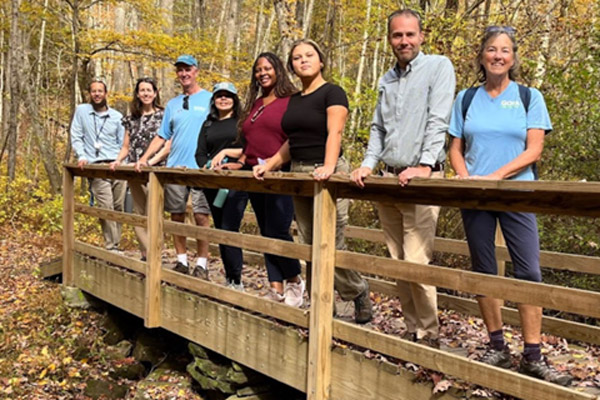With the first day of spring only a few days past, and Easter only days away, perhaps there is no better time to reflect on a sad bit of news: that New England’s only native cottontail rabbit is in peril. The New England cottontail (Sylvilagus transitionalis), once common in shrubby thickets in the Northeast, has lost 86 percent of its historic range due to habitat loss, displacement by the introduced Eastern cottontail (Sylvilagus floridanes), and an increase in many predators. Because of the dramatic decrease of the native cottontail population, this species is now, perhaps surprisingly for some, a candidate for protection under the Federal Endangered Species Act.
You may be thinking, how can that be possible when I see cottontail rabbits in my N.E. neighborhood all the time? The fact is, Eastern and N.E. cottontail species are very difficult to distinguish. There are only slight variations in footprints, skull shape, markings, size, and ears. Even experts have to rely on DNA pellet sampling to confirm the presence of the N.E. species. Though they may look alike, they differ in many essentials: the N.E. cottontail requires a very particular habitat, is less capable of detecting and escaping from predators, and also produces fewer young than its Eastern counterpart.
To the N.E. cottontail, the food and protection that a proper habitat provides is a matter of life and death. Unlike the Eastern cottontail, which can survive in a wider variety of smaller and less dense habitat types such as lawns and fields, the N.E. cottontail requires a larger, denser habitat area of at least 25 acres of shrub thickets and regenerating forests, among other features, to survive. A larger habitat can supply enough food to the cottontail to stave off starvation, especially during the winter; and a thicket made up of thorny plants like brambles and Greenbriar — virtually impenetrable to humans and predators like coyote and fox who like to forage along habitat edges — is essential for protection. Wily as always, these rabbit predators do well despite human encroachment; their populations have doubled in recent years. New England’s native rabbit would prefer to starve to death rather than leave the safety of its thicket to search for food.
The good news for the N.E. cottontail in particular, and diversity in general is that GOSA has several ongoing projects designed to provide the kind of habitat — affectionately termed “rabbitat” — that is crucial to its survival. Since 1986, GOSA has paid for the annual mowing at Haley Farm State Park to prevent its fields from reverting to forest. At The Merritt Family Forest, GOSA has completed a three-year project to restore an overgrown post-agricultural field to a shrubby transitional forest area. At the Sheep Farm, GOSA has embarked on a five-year program to remove invasive species and restore shrubby habitat. In addition, GOSA has met with fish and wildlife experts, a forester, and other consultants to devise a plan to restore 21 acres to rabbitat at Candlewood Ridge, our latest acquisition project. All of these measures will offer the N.E. cottontail a safer, healthier habitat.
Better yet, the N.E. cottontail will not be the only at-risk species to benefit from GOSA’s restoration efforts. Shrubby thickets and regenerating forests are prime habitats for many additional New England Species of Greatest Conservation need including dozens of breeding birds, several species of turtles, and northern black racer snakes. Paradoxically, many introduced plant species (such as multiflora rose, honeysuckle, Japanese barberry, oriental bittersweet and autumn olive) may contribute to the density of rabbitat, but they, unfortunately, spread at the expense of native species that would provide a better source of food (think whole wheat vs. Wonder bread) for the N.E. cottontail. So GOSA has been removing the introduced plant species and replacing them with natives. Some of the native plantings planned to create successional forest thicket* include: impenetrable prickly berry bushes like raspberry, blackberry, dewberry, and native rose species; nutritious grasses and herbs like goldenrod, rushes, clovers, chickweed, and wintergreen; and a wide variety of trees including varieties of maple, aspen, birch, apple, cherry, oak, and beech. In creating a
rabbitat for the native cottontail, GOSA hopes to help the many birds, insects, and mammals that need the food and protection found in large blocks of impenetrable thickets. It may take years, but the N.E. cottontail will eventually — finally — have a place to call home. That is a cheerful thought for spring.
*Succession refers to the natural replacement of one plant community by another. Examples of early-successional forest include idle agricultural lands reverting to old field habitats, mechanically cleared and re-growing areas such as utility corridors, young forests (25 years old or less) regenerating after natural or manmade disturbance, shrub swamps and brushy areas near beaver flowages, dense thickets of native shrubs, brambles and Greenbriar, and coastal shrublands where wind and salt spray inhibit the growth of forests.
Much of the information used in this article can be found in Arbuthnot, M. 2008. A Landowner’s Guide to New England Habitat Management. Environmental Defense Fund, 36 pp. This document can be downloaded online at http://www.edf.org/cottontail or print copies can be requested by contacting Anthony Tur at the U.S. Fish and Wildlife Service’s New England Field Office, (603) 223-2541. ?

